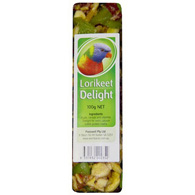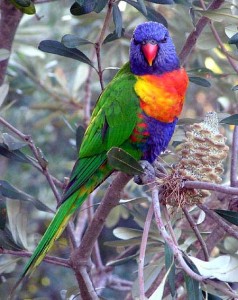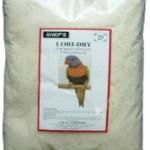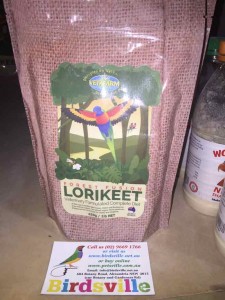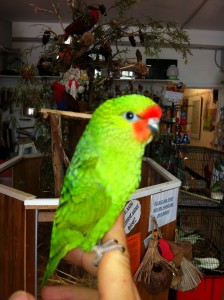 Little Lorikeet as Pets
Little Lorikeet as Pets
Distribution and Habitat
The Little Lorikeet is native to Australia, they range from Cairns down through Queensland and New South Wales from the western slopes of the Great Dividing Range eastwards to the coast. They are found in most of Victoria and southeastern South Australia. Small populations are even found in Tasmania. They are usually seen in forest areas, especially in the vicinity of flowering or fruit-bearing vegetation. The Little Lorikeets are often seen in flocks with Rainbow Lorikeets, Musk Lorikeets and Purple Crown Lorikeets.
Longevity
The life span of the Little Lorikeet is 15 to 20 years.
Description and Sexing
The Little Lorikeet is a small green lorikeet with a black beak and a red patch on the forehead and throat. They have a yellow tinged underbelly and their tail is green with red marking. Juveniles are duller in colour with less red on the face and brown beak. They grow to about 16 to 18cm, with a wing span of 24 to 28cm and only weigh 40g.
Males are richer in colour, but this can be difficult to tell sometime, so DNA sexing recommended.
Feeding and Care
The Little Lorikeet just like all lorikeets, in the wild, feed on nectar and pollen from plants and flowers.
In captivity one of the most common causes of premature death in lorikeets are infections caused by a poorly balanced diet or food that has been spoilt. There are many good quality commercial formulas available for lorikeets, that will provide the proper dietary requirements and nutrition for your bird.
There are two main types of commercial formulas, namely wet mix and dry mix. These mixes come in powder form. some good Quality ones include Vetafarm forest fusion, Wombaroo and passwell lorikeet.
If feeding dry mix, plenty of fresh drinking water needs to be made available for the bird. The power should be thrown out and feed containers washed every day.
If feeding wet mix, the mixture spoils easily should be thrown out and containers washed every day. In hot weather it will spoil faster than normal and may need to be thrown out and container washed more often. This is one of the reasons why dry could be better, but young lorikeet will need to be weaned off wet on to dry a few months after purchase. Their requirements for drinking will be reduced, as the feed contains a large amount of water, however fresh drinking water should still be made available at all times.
Little Lorikeets also need their diet supplemented with fresh fruit and vegetables on a daily basis. A variety of different fruit and vegetables should be made available. Spinach or silver beet leaves provide calcium for the bird a calcium supplement or calcium perch may also be used for calcium intake.
Other kinds of fruits and vegetables frequently enjoyed by lorikeets include apples, pears, corn on the cob, berries, grapes (only to be fed in small amounts as the high iron content in grapes can cause liver damage), pumpkins, sweet potatoes, and citrus fruits (only once a week). Fruit and vegetables should be removed at the end of each day and no be allow to accumulate at the bottom of the cage.
Do not feed your bird (or any other bird) avocado, onion, chocolate, caffeine or alcohol. These foods contain chemicals which are lethal to birds.
Little lorikeets will also eat small quantities of millet spray, oats, canary grass sees and sprouted sunflower.
If you are unable to need the nutritional requirement for your lorikeet, vitamins and mineral supplements will need to be provided.
It is important to make sure the cage is clean weekly, including all toys, perches and feed containers.
Housing
Little Lorikeet are a very active birds and recommended that you house your bird in the largest cage you can afford. Even though these birds are small, you have to remember that you need room for the many toys, swings, perches, food/water dishes, as well as providing sufficient space for them to move around and exercise their wings.
Little Lorikeets as an Aviary Bird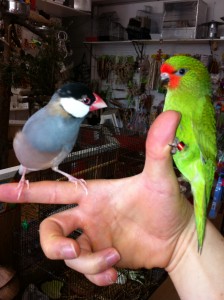
In larger aviaries, Little Lorikeets mix well with other Little lorikeets, Purple Crown Lorikeets, pigeons, doves, quails, finches and other small parrot. With any birds always be careful when introducing a new bird into the flock as sometimes just like people an individual can have a bad attitude. It is recommend when introducing a new bird into the flock, to have what I call a soft release cage. The new bird is place in this cage inside the aviary and all birds are able to adjust, interact and get use to each other. After two weeks then introduce the bird into the aviary. This should stop the original bird from mobbing the intruder.
Enrichment
Little Lorikeets are very playful, you should provide your bird with foraging toys, nontoxic plastic toys, ladder and ropes. They love toys that make noise, such as bells and toys they can chewing, such as wood, rope and leather. Swings are important not only for play, but to strengthen their legs and improve balance.
A bird bath should be provided to allow bird to bath. Natural branches for perches and climbing should be place in your birds’ cage, make sure branches are rinsed well before hand to remove any bacteria or unwanted germs.
Little Lorikeets as pets
Little Lorikeets make great pets and are becoming more popular due to their intelligence, entertaining personality and stunning beauty. They are a good beginner’s bird as they are affectionate, curious, and exhibit some unique behavior.
Young birds should be socialized to many people and exposed to a variety of situations such as new cages, toys, visits to the veterinarian, handling by friends, and wing clippings to avoid fear of novel situations.
These birds are not known for their talking ability, but for their playful personality trails and their behavior.
Worming- have you wormed your bird?
Your bird will need to be wormed in a few weeks to two months after being taken home check with the staff from Birdsville, when purchasing). Young birds that have been recently weaned have a delicate bacteria’s developing in their gut, worming at this stage could harm the bacteria’s development and your new bird. Worming will need to be done.
every 6 months. Worming your bird is essential for the health of all parrots in captivity.
Lice & Mites
These are the two most common parasites of cage birds and their environment but are easily controlled with a Mite and Lice spray, available at Birdsville. When using spray, spray bird, entire cage, perches, nesting box and toys, remember to remove all water and feed and avoid spraying in birds’ eyes. Your bird Lice and mite bottle will explain how to use, remember avoiding the mouth and eyes.
Training Your Bird
Training is an important factor of having a well-behaved hand raised bird. When you first get the bird home, let it settle down and get use to their new environment for a day or two. After these initial days, the bird should be handled in a quiet, relaxed situation. Spending time with your bird while watching TV or reading is perfect, but don’t over stress your bird in the first few weeks of taking it home, babies need their rest. The more time you spend with your bird, the better your bird will become.
When doing any training there are three basic concepts to keep in mind.
- When the bird does something good –> give it a reward.
- When the bird does something undesirable –> ignore it.
- Never punish your bird
Start training your bird with a simple command, like step up.
Have the bird on one hand, place the other hand against the birds’ chest and say the command, step up, as you apply a slight pressure to the birds’ chest. The bird will then put one leg up, pull slightly up with the second hand and the other leg will follow, reward your bird with a treat, like a favorite fruit, seed or nut. Then repeat, as the bird gets better, get it to step up a few times before rewarding. Once your bird catches on to it, instead of rewarding it with food, reward it with praise. This will soon become second nature to the bird.
It is important not to overdo the training, keep it short, but frequent.
Breeding
Little Lorikeet are sexually mature at 12 months of age. The male will court female, by hopping towards her as he bobs his head up and down, while wiping his beak along the perch.
The Little Lorikeet breeding season starts in August and continues through to January. They require a nest box size of 30.5cm x 15.2 x 17.8cmH with parrot nest material, which is available at Birdsville.
Little Lorikeets will lay a clutch of 3 to 4 white eggs, which are just under 2cm long. The incubation period is 22 days. The chicks fledge at around 30 days and start to feed on their own around 7 weeks old.
What to Look for When Purchasing a Little Lorikeet
When you are ready to purchase your new Little Lorikeet, here are so few hints for what to look for.
- Eyes – should be bright and clear, there should be no discharge, swelling or redness. If the eyes that are runny, squinty, or discolored can be an indication of infection.
Condition- This is very important and should be understood by any bird owner as a bird handler every time i touch any bird i feel the bird’s condition by touching the birds keel bone which is underneath the bird this is the anchor where the birds large wing muscles attach to allow the bird to have strong wing muscles for flight. When a bird is unwell the first thing that usually happens is they lose weight, and their breast muscle becomes very light on. Because of birds very high metabolic rate they can lose weight very quickly and become ill so this should be checked by bird owners on a regular basis especially if they see there bird not as active as normal.
- Mouth and beak – should be clean and
- Mouth and beak – should be clean and free of injury, no lesion, wetness or build up inside the mouth. The beak should not be overgrown.
- Nose, nostrils or cere – should be open and free of discharge.
- Feathers – the bird should be fully feathered and sleek with a smooth appearance. Depending on the age, sometimes the tail feathers will be somewhat ragged due to young birds regularly walking through there wet food and having them rub on objects and wire.
- Wing Clipping – if wings are clipped, both wings should be clipped, not just one and all outer feathers should be cut. If the last two outer feathers are not cut the bird could injure themself and if only one wing is only clipped the bird still may fly, just lopsided and cause injury when landing. Birdsville will clip wing for free with any purchase.
- Weaning – it is highly recommended, if you don’t have hand raising experience, only weaned birds should be bought. Hand feed might look and seem like a simple process, but it can be easily done incorrectly and time consuming. Mistakes when hand feeding can cause irreversible harm and even lead to death of the young bird. Alway choose birds that are fully weaned and eating independently. Your bond with the bird will not suffer for it in the least.
- Voracious eaters – observe the birds that you’re interested in, and you should look for birds that are the most voracious eaters. Choose a bird that displays a large appetite. This is an indication of good general health and wellbeing.
- Dirty vent (anus) – there should be no staining or fecal matter on the feathers around the vent.
- Leg – should look clean.
- Clean enclosure – the enclosure where the birds are kept should be clean and hygienic, to reduce the likeliness of illness or infection.
- Active and alert – The bird should be active and alert. If it appears sluggish or weak it could be ill or too young to be feeding on its own.
Species Specific Problems and how to avoid them.
- Yeast infections – Can be caused by of the high sugar content.
Signs to look out for: Your lorikeet is uncharacteristically lethargic and not his normal energetic self.
If Your lorikeet is not behaving normally seek vet advise as soon as possible.
- Fungal infections – Is a common illness in lorikeets and can be caused by a number of reasons. Most commonly it is from poor housing or contaminated food. A lack of vitamin A in their diet can cause the bird to pick up something they shouldn’t.
To minimize the possibility of contacting a fungal infection, keeping them in a clean environment, by regularly cleaning their cage, providing fresh food that is rich in vitamin A, such as carrots and sweet potato and make sure the water is fresh and clean.
- Bacterial infections- Birds can become ill from a variety of bacterial infections found in a home environment which can be contracted from the floor, kids and other animals. Stress can be a large contributing factor making them more prone to sickness.
If your bird is not as active as normal and appears fluffed, immediately upkeep it warm with a heat lamp or a heater close to the cage. Broad-spectrum antibiotic powder is available at Birdsville, which goes into the water or contact a vet immediately.
- Beak and feather disease – Better known as BPFD virus or BPFDV is infectious to all parrots and is usually spread by feather dust and droppings. This is why the virus has become too common and prevalent all over the world and Australia.
Many young birds that have beak and feather disease die at a very early age before they leave the nest. Others show many symptoms from a very young age. These symptoms are often losing feathers but many lorikeets after a while build up an immune response and in time will grow their feathers back as if they never had the virus at all and live a long healthy life. These birds are generally immune from the disease, but probably become carriers for the remainder of their lifetime.
Some birds which have a weak immune system that contract the disease can become ill and eventually die.
There is no vaccine to beak and feather disease, but you can increase the odds for your living a long and happy life by giving your bird a healthy diet, clean environment and eliminating stress.
Which brings us to our next important point.
- Stress- When I was a zookeeper one of our most important jobs was to eliminate stress, as this can be the one of the biggest issues with any animals kept in a captive environment. Eliminating stress is as simple giving your Little Lorikeet the correct environment they need. When they are adults, they love noise and attention, but for young baby birds, in a new home, you do not want to over stress them. Often over excited kids can stress a bird out with too much love and grabbing, chasing etc. Give them time to get used to their new environment to feed and drink and rest. Birds that are stressed are more susceptible to viruses and infections named above.
- Obesity- Obesity is an issue for many captive birds and can result in early death. It is important to having a large cage with swings and different size perches. It is also important for them to have some time to exercise out of the cage, this will help your bird burn some calories. Another major fact is diet, your bird should have a healthy diet with plenty of fresh fruit. There are low fat lorikeet food options available at Birdsville.
- Trauma and injuries- Broken leg, beak, wing and feet. As with any small bird’s damage and injury can occur by simply letting your bird out of a cage and he flies into a window or another common injury in household pets is them flying into a ceiling fan. To avoid this with unclipped birds, you will have to let your bird become use to their new environment making sure all windows are shut, ceiling fans turned off and your bird is supervised while out of the cage. If any of your birds receive any traumatic injuries, you should take your bird to the vet immediately.
Household dangers for hand raised birds.
- Dogs and cats – if not socialized properly can be a big danger for prey animals such as birds. Little Lorikeets must be supervised at all times with a dog or cat in the house. This may be difficult with hunting breeds of dogs and some cats. The resident animals must have some time to get used to the new family member and accept them as a member of the family. I cannot stress enough please be very careful in introducing any new animal as they can be very unpredictable.
- Ceiling fans – Owners of birds can easily forget to turn off ceiling fans when they let the birds out of the cage for a fly which can have disastrous results.
- Windows, doors and mirror
- Poisons – Inhaling or eating toxic substances such as zinc, copper, bleach, oven cleaner, glues, nail polish remover, paint and insecticides to name a few.
- Open water – if a bird falls into a sink full of water or even headfirst into a coffee mug can drown a bird.
- Electric cords
- Inappropriate foods – such as alcohol, chocolate, onion and avocado.
- Drafts – Can be one of the biggest killers of birds causing them to become sick, so keep your feathered friend in a draft free zone.
- Infections – picked up in an unclean house.
